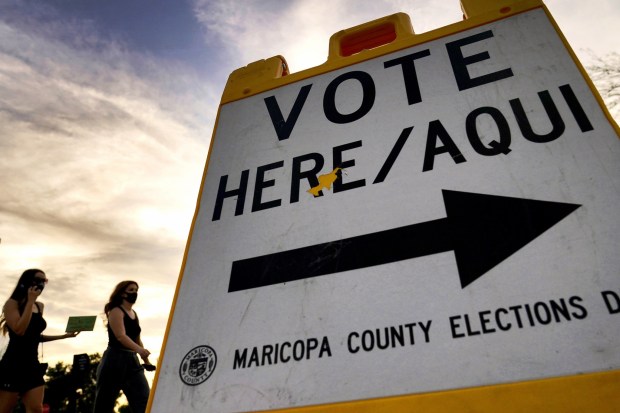In the viral TikTok video, Vice President and Democratic presidential nominee Kamala Harris appears to be slurring her words while giving a speech. Comments on the video quickly sounded off that she was drunk.
But, when looking at the video closely, it is clear that it had been edited and slowed down to give the impression that Harris was slurring her words, which was evident in the audience applause sounding unnatural and much slower as well, said Nicholas A. Casas, assistant librarian for teaching and learning at Indiana University Northwest, who has used this example to teach about disinformation.
A quick Google search of “Kamala Harris drunk speech” will reveal multiple credible news organizations, like USA Today and Reuters, with articles debunking the claim that she was drunk by including the full-length clip of her speech and not a seconds-length clip, Casas said.
“If Kamala Harris really was drunk on stage, everyone will be reporting on it,” Casas said. “It only went viral on a small, fringe group of social media accounts. That’s when we talk about checking to see if other news sources are reporting on this as well. That was quickly, easily debunked.”
Taking the steps above, evaluating the initial video, thinking critically and searching for other sources, is the best way to fight misinformation, disinformation and malinformation, especially amid the election cycle, Casas said.
Casas, also the coordinator of library instruction, said he teaches students research skills, critical thinking skills and information literacy for their papers or research projects. Since 2017, Casas said he has also taught digital and news literacy to senior citizens as part of the university’s Center for Urban and Regional Excellence Senior University, which offers seminars for senior citizens.

To avoid reading misinformation, which is the sharing of false information unknowingly; disinformation, which is sharing false information on purpose to create harm; and malinformation, sharing true information used for malicious reasons, like publishing someone’s personal information online to cause harm, Casas said people have to read laterally using the SIFT method.
SIFT, which was developed by Mike Caulfield at the University of Washington, which stands for stop, investigate the source, find better coverage and trace claims back to the original context, Casas said.
“The whole point is to evaluate where the information is coming from – so identify who the author is, what the website is, who the organization is – and to critically evaluate them and see what other people are saying about that organization,” Casas said.

This is a file photo of a polling station in Tempe, Arizona on Nov. 3, 2021. A review of potential voter fraud cases in the 2020 general election in Arizona’s second-largest county ended, Jan. 14, 2022, with an announcement by prosecutors that none of the 151 cases they reviewed merited criminal charges. The findings in Pima County provide yet another official rebuttal to former President Donald Trump’s claims that voter fraud led to his loss in Arizona and other battleground states. (Matt York / AP)
When teaching about finding better coverage and tracing claims back to the original context, Casas said he focuses on context.
“Context is everything. A lot of misinformation and ‘fake news’ is actually true information put into a different light or maybe a snippet of something that’s true and put into a completely different context,” Casas said.
Political advertisements, Casas said, are an example of that because they are designed to sway voters and not necessarily inform them on an issue or candidate. The advertisements pull snippets from what candidates said, which Casas said could be taken out of context.

Purdue University Northwest associate professor of political science Yu Ouyang said as voters research candidates they should search multiple news organizations and websites, as well as utilize fact-checking websites like factcheck.org and politifact.com.
Casas agreed, adding that he also tells people to avoid the “about us” sections on an organization’s website because it will be biased. Casas said he also teaches about the journalistic approach to the 5 W’s — who, what, when, where, why — and the work journalists do to report and present the news.
Another example Casas gives is comparing the American Academy of Pediatrics, the largest professional association for pediatricians, and the American College of Pediatricians, a Southern Poverty Law Center designated hate group for its anti-LGBTQ views. In his seminar, Casas said he shows articles published by the AAP and the ACP and the group compares them.
“A lot of these hate groups, misleading organizations, these disinformation organizations, they like to disguise themselves as legitimate associations, but you just got to look deeper and see what other websites are saying about them, or what other organizations are saying about them and take a really deep dive of that,” Casas said.
Voters should also watch for rhetoric politicians use, Ouyang said, because it reflects the candidate’s policy beliefs and is tailored to the group of voters listening to the speech. For example, a politician speaking at a union hall will address issues most important to union workers, he said.
“Which means that voters are very powerful in that we have a lot of effect on what candidates say and how they say it,” Ouyang said.
At this point in the campaign cycle, Ouyang said voters will likely notice similar messaging from candidates, particularly from candidates in tight races, because they have identified what messages resonate with voters. Basically, the time for testing messaging is over, he said.
Voters should research the policies politicians bring up, Ouyang said, because sometimes repeating the same message could give voters the impression that a policy issue is more important than it is.
“It’s simply a message that candidates think will resonate with more people to get them energized to vote,” Ouyang said.
Over the years, Casas said he’s seen a shift in how misinformation has been created because of the recent use of AI and the lack of verification on social media platforms.
Misinformation and disinformation have been around since the creation of the printing press, Casas said, so it’s unlikely to be eradicated. But, Casas said misinformation researchers and educators are working toward getting people out of their information silos and expanding where they get their news from to help limit misinformation.
The silo shift, Casas said, includes encouraging people to also watch or read their local news instead of constant national news.
“It’s teaching them to take a step forward and to simply see what other media outlets are reporting on this, and don’t just trust what you are seeing on a daily basis,” Casas said.



